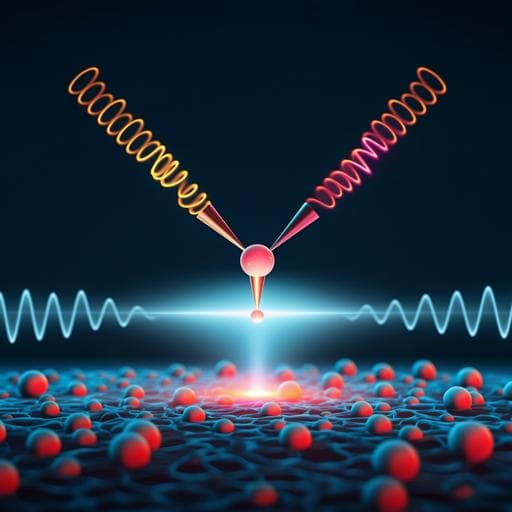
Physics
A quantum sensor for atomic-scale electric and magnetic fields
T. Esat, D. Borodin, et al.
Discover groundbreaking research that unveils a single-molecule quantum sensor capable of detecting faint magnetic fields at the atomic scale. This innovative work, led by Taner Esat and colleagues, demonstrates remarkable energy resolution and opens new avenues in atomic-scale quantum sensing.
~3 min • Beginner • English
Introduction
The study targets the creation of a mobile quantum sensor with atomic spatial resolution and high energy sensitivity capable of detecting electric and magnetic fields from individual atoms on conducting surfaces. Conventional NV-center-based scanning sensors offer excellent coherence and room-temperature operation but are limited to tens of nanometres spatial resolution because the sensor lies ~10 nm below the diamond surface, preventing atomic resolution. Functionalized scanning probe tips can enhance spatial resolution but typically rely on non-resonant spectroscopies with meV-scale energy resolution and lack coherent spin control. STM-based ESR on surface-adsorbed atoms demonstrates single-atom spin resonance and sensing but the sensor is stationary and commonly requires an insulating decoupling layer. The authors hypothesize that an upright-standing molecule at the tip apex can host a decoupled spin-1/2 qubit that is addressable by ESR on metallic substrates, enabling a fully integrated, mobile quantum sensor capable of mapping atomic-scale electric and magnetic fields with sub-angstrom resolution.
Literature Review
- NV centers in diamond have enabled nanoscale magnetometry with excellent coherence and optical initialization/readout, yet spatial resolution is limited to ~10 nm due to sensor burial and hence atomic resolution is not realized.
- Tip-functionalized molecules and atoms have enhanced atomic-scale imaging of chemical structure, surface potentials, and magnetic exchange interactions via non-resonant STM/AFM methods, but their energy resolution is thermally limited (~1.5 meV at 5 K) and lack coherent control.
- Terahertz and ESR-STM techniques have enabled coherent spin manipulations of individual atoms or small molecules on surfaces, and even local-atom sensors for magnetic moments, yet previous sensors were not mobile and typically used insulating films for spin decoupling.
- Prior work on standing PTCDA on Ag(111) established a spin-1/2 with very low Kondo temperature (~290 mK), indicating strong decoupling from the metal and suitability as a qubit/sensor. The present study builds on these to realize a mobile, ESR-addressable, tip-mounted molecular spin sensor on a metallic substrate.
Methodology
Experimental platform: A home-built STM operating at 1.4 K with a two-axis vector magnet and wide-range ESR capability. PtIr tips were Ag-coated in situ. Differential conductance was measured by lock-in; ESR spectra in continuous-wave mode were recorded by applying RF voltage V_RF added to DC bias V_DC and monitoring tunnelling magnetoresistance.
Sensor fabrication: On Ag(111) in UHV, single Fe atoms and PTCDA molecules were deposited at ~10 K. A spin-polarized tip was prepared by transferring up to three Fe atoms from the surface to the Ag-coated tip using 1.6–1.9 V withdrawal pulses near point contact. Then, one carboxyl oxygen of an isolated PTCDA was contacted, forming a covalent bond to the tip. The molecule was pulled vertically by ~12 Å to a metastable upright configuration, becoming a singly charged radical with a spin-1/2 decoupled from the metal. The effective presence and geometry of standing PTCDA on the tip were confirmed by imaging a surface Fe atom (acting as a tip-on-surface) and by atomically resolved Ag(111) imaging. dI/dV spectra showed an asymmetric zero-bias step characteristic of a spin-1/2 with a spin-polarized tip. Comparative studies with standing PTCDA on engineered Ag+Fe or Fe+Fe pedestals revealed inelastic spin excitations and lack of ESR activity, indicating that the ESR-active tip sensor stands on an Ag+Ag pedestal and is not directly bonded to Fe; Fe atoms on the tip provide spin polarization and ESR driving/detection but are not bonded to the molecule.
ESR detection and calibration: ESR spectra over bare Ag(111) were recorded while sweeping RF frequency f to locate resonances f0 under various external field magnitudes and orientations (in-plane B_|| and out-of-plane B_⊥). Driving is attributed to modulation of exchange fields by the RF electric field (or possibly piezoelectric coupling), converting RF electric to effective RF magnetic drive. The spin state readout relies on tunnelling magnetoresistance via Fe atoms on the tip. Resonance linewidths (Lorentzian fits) yielded FWHM of 157 MHz at V_a = 15 mV and 93 MHz at V_a = 4 mV.
Effective field and quantization axis: The sensor experiences B_eff = B_ext + B_tip. From f0(B_ext) for both orientations, an offset f0 at B_ext → 0 of −25.5 GHz was observed, corresponding to |B_tip| ≈ 0.9 T (assuming isotropic g ≈ −2). Modeling included tip-field bistability (180° flips along an easy axis) to fit f0 vs B_ext and deduce the orientation of B_tip, B_eff, and the sensor quantization axis e for each condition.
Electric-field transduction: The sensor’s resonance shifts linearly with V_DC at constant height. To quantify the transduction parameter γ (GHz mV⁻¹), f0(V_DC) was measured in constant-current mode and corrected for concomitant z changes using two auxiliary measurements: (i) f0 vs setpoint current I (slope 25.8 MHz/pA at V_DC = −70 mV) and (ii) constant-height I(V). After correction, γ = −0.047 GHz mV⁻¹. For a normal tunnelling distance z ≈ 15 Å, this implies an electric field coupling strength δ = γ z ≈ 66 MHz µm V⁻¹, ~400× larger than NV centers under comparable conditions.
Sensing protocol and modeling: To measure local fields from a target object (Ag dimer or Fe atom), a ~100 Å area around the object was cleared. The sensor was laterally approached while recording ESR spectra at fixed setpoints, at x ≥ 10 Å to avoid exchange coupling. Measurements at B_⊥ = ±0.5 T and B_|| = ±0.5 T enabled separation of electric and magnetic contributions. The shift relative to a far reference position (x = 45 Å) is Δf0(r) = φ(r)/α(z) + [1/γ] E_dd(r), where φ(r) is the electrostatic potential and E_dd the magnetic dipole-dipole interaction energy. The electric potential contribution from Ag2 and Fe was modeled via a point-dipole potential convolved with a normalized point-spread function (PSF) that includes image-charge screening by both metallic tip and sample, eliminating the unknown α(z) by normalization. PSFs were precomputed for z in 0.5 Å steps. Best-fit parameters yielded the electric dipole moments and sensing height z.
Magnetic dipole extraction: For Fe, in-plane data indicated negligible magnetization (m_Fe ≈ 0) under B_||, so Δf0 reflected only the electric potential. For out-of-plane fields, subtracting the two polarities isolates the magnetic term, Δf − Δf0 = E_dd/ħ. Fitting the dipole-dipole interaction using the deduced sensor moment orientation and z = 14.5 ± 1.0 Å yielded the Fe magnetic moment and verified the r^−3 dependence (β ≈ 3.1).
Key Findings
- A fully integrated, mobile single-molecule quantum sensor was realized by attaching an upright-standing PTCDA molecule and Fe atoms to an Ag-coated STM tip apex, operating directly over a metallic Ag(111) surface (no insulating layer required).
- ESR-active spin-1/2 molecular sensor with energy resolution ~100 neV; ESR linewidths (FWHM) of 157 MHz (V_a = 15 mV) and 93 MHz (V_a = 4 mV).
- Tip field and quantization axis: Resonance offset f0(B_ext→0) = −25.5 GHz corresponds to |B_tip| ≈ 0.9 T; bistable B_tip orientation explains two ESR lines under certain fields.
- Electric-field transduction: γ = −0.047 GHz mV⁻¹ (constant-height corrected). For z ≈ 15 Å, electric field coupling δ ≈ 66 MHz µm V⁻¹, ~400× larger than NV centers. Linear f0(V_DC) shift for both polarities indicates coupling to electric field.
- Electric dipole moments (via PSF fits): Ag dimer p_Ag2 = 0.84 ± 0.02 D; Fe atom p_Fe = 0.89 ± 0.02 D. Electric field sensitivity is ~20× higher than SQDM at 1.4 K.
- Magnetic dipole of Fe: |m_Fe| = 3.2 ± 0.4 μ_B (out-of-plane, saturation at −0.5 T); r^−3 dependence confirmed (β = 3.1 ± 0.05), consistent with literature (≈ −3.1 ± 0.1 μ_B).
- Spatial resolution: ESR peak shifted by ~760 MHz between x = 10 Å and 15 Å with FWHM ~120 MHz, implying at least ~0.8 Å resolution; with peak fitting, lateral resolution <0.2 Å.
- Yield: ~5% of assembled tips (standing PTCDA + Fe) exhibited ESR-based sensor functionality; others showed inelastic spin excitations and no ESR.
- The sensor can operate also as a conventional STM imaging probe with atomic resolution, enabling precise positioning prior to sensing.
Discussion
The work addresses the long-standing challenge of detecting atomic-scale magnetic and electric fields on conducting surfaces with both high spatial and energy resolution using a mobile sensor. By decoupling a molecular spin via an upright-standing configuration on a metallic tip, the authors realize ESR addressability without an insulating film. The ESR response maps directly to local electric potentials and magnetic dipole-dipole interactions, enabling quantitative extraction of dipole moments from single atomic-scale objects (Ag dimer and Fe adatom). The method achieves sub-angstrom spatial resolution and ~100 neV energy resolution, significantly surpassing non-resonant STM spectroscopies and complementing NV-based sensors by providing truly atomic-scale proximity and mobility. The electric-field sensitivity (δ ≈ 66 MHz µm V⁻¹) is substantially enhanced (~400×) compared to NV centers, and ~20× better than SQDM at similar temperature, owing to the ESR-based readout and sensor geometry. The results validate the sensor’s ability to disentangle electric and magnetic contributions via vector-field control and polarity subtraction, and the extracted Fe magnetic moment matches prior reports, underscoring quantitative accuracy. This platform opens avenues for atomic-scale sensing of spin textures in quantum materials and for probing spin-labelled biomolecules on conductive substrates.
Conclusion
The study demonstrates a tip-integrated, mobile quantum sensor based on an ESR-active standing PTCDA molecule on an Ag-coated STM tip augmented with Fe atoms for spin polarization. Operating over a metallic surface, the sensor achieves ~100 neV energy resolution and sub-angstrom spatial resolution, enabling quantitative imaging of local electric and magnetic fields from single atoms. Quantified results include p_Ag2 = 0.84 ± 0.02 D, p_Fe = 0.89 ± 0.02 D, and |m_Fe| = 3.2 ± 0.4 μ_B, with electric-field sensitivity far exceeding NV-center and SQDM approaches at cryogenic temperatures. The concept removes the need for insulating films in ESR-STM, facilitating mobile, atomic-scale quantum sensing on conducting surfaces. Future work could integrate pulsed ESR for coherence-based protocols, employ the sensor as a mobile qubit coupled to surface qubits, and apply this sensing to catalytic centers and spin-labelled biomolecules with atomic precision.
Limitations
- Fabrication yield: Only ~5% of assembled tip sensors (standing PTCDA + Fe) exhibited ESR activity; most configurations showed inelastic spin excitations and no ESR.
- Operating conditions: Experiments require ultra-high vacuum and cryogenic temperatures (1.4 K). Energy resolution and coherence depend on low temperatures and environment stability.
- Tip-field bistability and modeling: The orientation and magnitude of the tip field B_tip must be inferred via modeling and can flip, producing multiple resonances; sensor response depends on tip-specific anisotropies.
- Distance constraints: To avoid exchange interactions with targets, sensing was performed at lateral distances ≥10 Å, which sets a practical lower bound on approach in this study.
- Generalizability: Transduction parameters (γ, a, δ) and sensing height z depend on the specific sensor assembly; calibration is required for each sensor. Present address/geometry variations can alter sensitivity.
- Magnetic sensitivity orientation: For in-plane fields, Fe magnetization on Ag(111) was below detection, requiring out-of-plane fields to measure magnetic moments; saturating fields are needed for paramagnetic adatoms.
Related Publications
Explore these studies to deepen your understanding of the subject.







